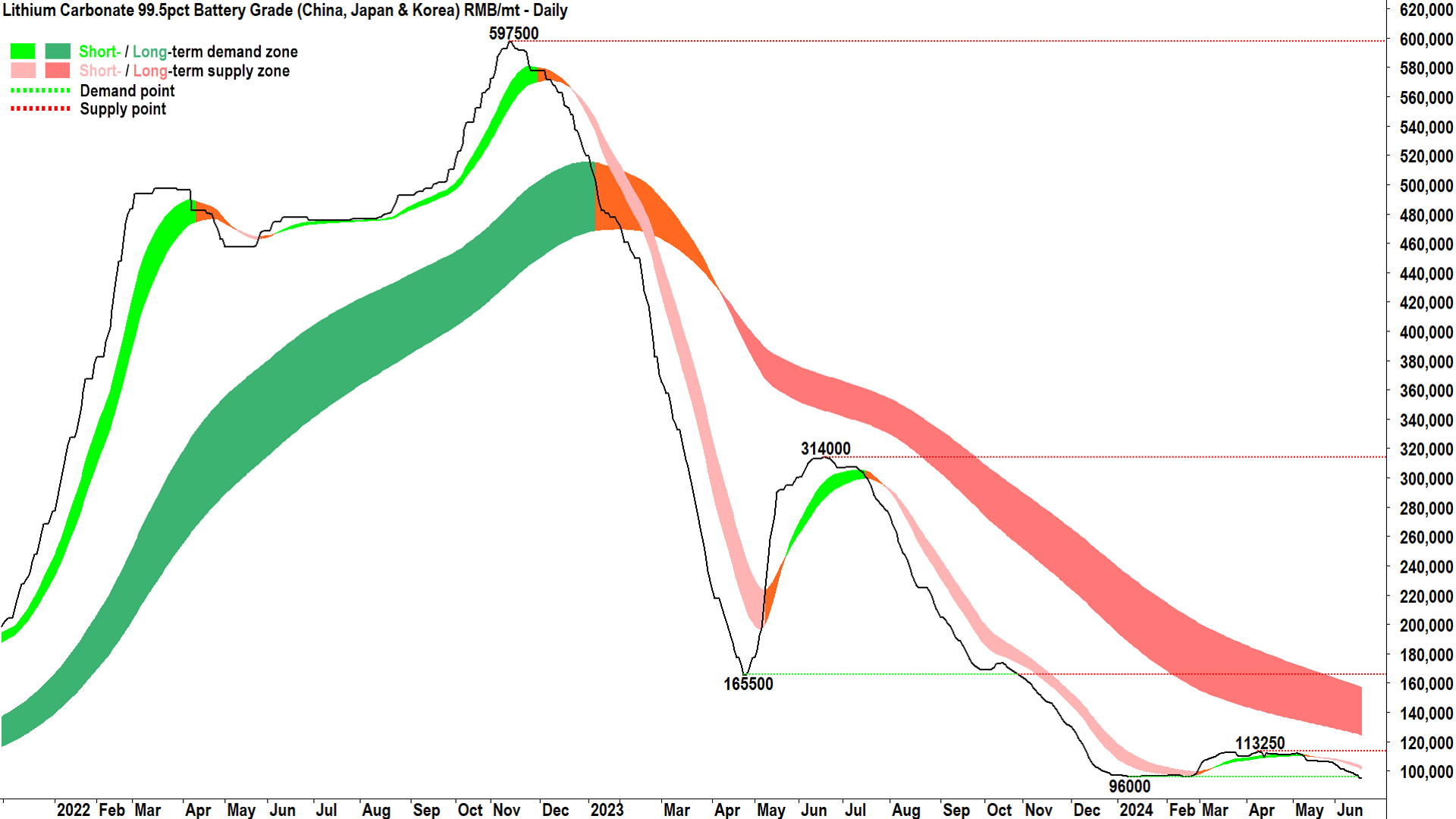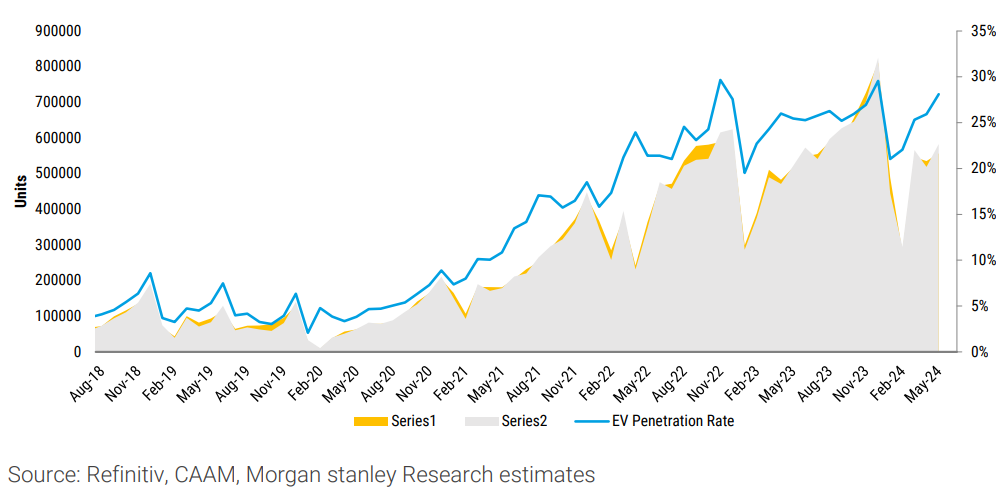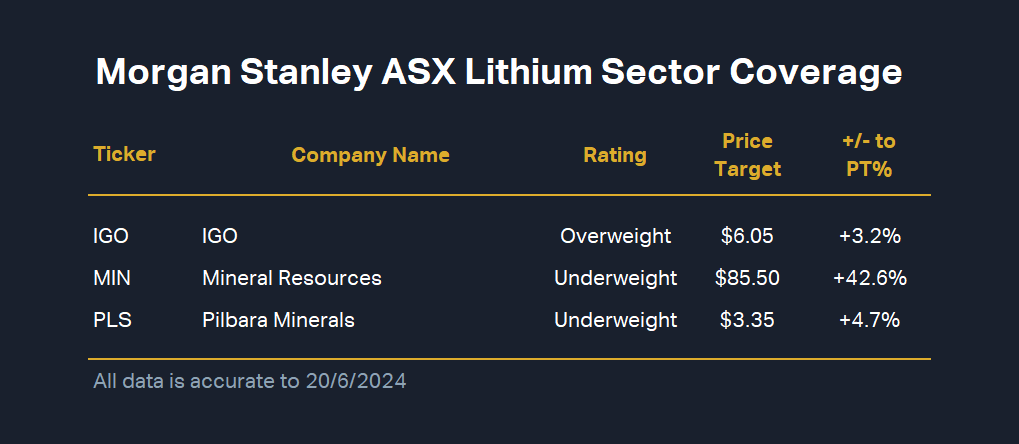Don’t hold your breath lithium investors, unless you can do it for 4 years…
Lithium investors are a tough bunch. They’ve ridden the roller coaster up, down, and after a modest rally through the first part of 2024, down again.
Despite the slide in lithium prices, I continue to see a great number of positive affirmations among lithium bulls across various social media channels. It seems their conviction that investing in lithium stocks will prove to be rewarding in the long run remains as strong as ever.
%20spot%20RMB-t.png)
FYI lithium bulls, I report everything lithium that comes across my desk – I don’t pick and choose – and I can confirm I don’t have any positions in lithium stocks. My interest in this space is purely as a student of the markets, and as someone who has seen several cycles over 30 years of investing.
So, if there’s a negative view on lithium in this article – blame the person(s) with the view – not me!
This time, you’ll have to blame major broker Morgan Stanley. In a research report that dropped yesterday, the broker provides details of a webcast they recently hosted for clients with major energy transition data and analytics think tank Wood Mackenzie (“WoodMac”).
There’s actually quite a bit of good news for the lithium outlook in the report, mainly on the demand side. But ultimately, it’s what’s happening on the supply side that results in a price prediction suggesting potentially many more years of pain for lithium investors.
Yes, demand is bottom-left-top-right, but what about supply?
Let’s do the good news first. WoodMac pointed out the following bullish points for lithium demand:
“Lithium (Li) demand to remain robust, driven by the energy transition and decarbonisation”
Electric vehicles (EVs) are likely to remain a “key driver” of Li demand
Battery electric vehicles (BEV) and plug in hybrid electric vehicles (PHEV) sales are expected to grow at a compound annual growth rate (CAGR) of 11% globally for the next 10 years
In this time, BEV/PHEV penetration rates should reach 54% in the USA (vs current 10%), 66% in Europe (vs current 23%), and a massive 75% in China (vs current 40%)
Now for the bad news. As I regularly try to remind investors in my Twitter/X feed, bottom-left-top-right charts of demand for a commodity may stoke bullish animal spirits and hopes of snagging the next big thing – but they don’t make a complete investment thesis.
For this, one must also consider the supply side of the equation. From WoodMac:
Since 2022 lithium supply capacity has “ramped up significantly”
New projects coming online in this year and next could add 878kt lithium carbonate equivalent (LCE) or a substantial 68% of supply to current
The major increase in supply is coming from China, Australia, Chile and Argentina (and Chinese lepidolite isn’t going away – it will continue to play a major role, making up around 10-12% of total supply)
All the above means supply in 2025 will be double what it was in 2023
As a result of these demand-supply factors, and the resultant supply surplus they would create, WoodMac believes lithium prices would “remain under pressure between 2024-28”. The price of battery-grade lithium carbonate is unlikely to trade above US$15,000/t over this time (it's currently trading at $US13,000/t), before rising to around US$35,000/t in 2034.
That last part, at least, is significantly bullish – but can lithium investors hold out for as long as another four years to get to the good stuff thereafter? Basically, you could watch the upcoming Paris Olympics plus the next one in Los Angeles before prices are expected to recover.
For those who watch the spodumene price, the corresponding numbers from WoodMac are US$1,000/t out to 2028, and US$2,200/t in 2024 (it’s currently trading at US$1,096/t).
China EV sales up in May, NEVs leading
In a separate research report that also dropped yesterday, Morgan Stanley provided an update on EV sales in China based on the recently released data for May. The data is related, so I thought I would give you a few bullet points here too.
Pure EV 12% in May for 8% year-on-year growth, benefitting from national replacement subsidies and new launches
Neighbourhood EVs (NEV) (i.e., low-speed vehicles) penetration grew 3.1% in May to 46.7% - a third consecutive record month
PHEV's sales continue to dominate the market, outgrowing BEV counterparts (+86% y/y vs +9% y/y respectively)

Exhibit 1: May saw an increase in China pure EV sales from April, but >75% of NEV growth YTD in China has been from PHEV's (incl EREVs). Source: Morgan Stanley Research estimates (From: “DataDig: NEV's (not EVs) showing strong growth”, Morgan Stanley Research, 19 June, 2024)

On the last bullet point, the issue for lithium prices here is that PHEVs use less lithium than BEVs, and this trend is one of the key reasons why Morgan Stanley commodity strategists see further downside for lithium prices in the second half of 2024.
~70% less lithium is used in PHEVs, a switch in consumer preference from BEV to PHEV could lead to bigger near-term lithium surpluses
—Morgan Stanley Research
The result is that Morgan Stanley has retained its “negative stance” on ASX-listed lithium stocks. See below, the broker’s current rating and price targets for the main players.

The most interesting thing for me is, after considering the recent precipitous plunges in the share prices of the above trio, Morgan Stanley’s price targets don’t look so negative anymore.
This article first appeared on Market Index on Friday 21 June 2024.
5 topics
3 stocks mentioned

